| | | | | | | | | | | | | | | | | | | | | | | | | | | | | | | | | | | | | | | | | | | | | | | | | |
| | | | | | | | Menu | | | | | | | | | | | | | | | | | | | | | | | | | | | | | | | | | | | | |
| | | | | | | | | | | | Guru
Amardas -- The 3rd Guru Nanak | |
| | | | | | | | | | 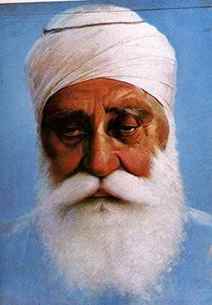 | | | | | | | | | | | | | | | | | | | | | | | | | | | | | | |
| | | | | | | | | | | | 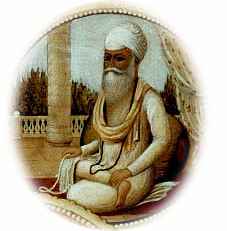 | | | | | | | | | |
| | | | | | | Guru
Amardas, the third Nanak, was born in 1479 AD at village Baserke in Amritsar district.
The name of his father was Tej Bhan (of Bhalla sub-caste). He was married to Mata
Mansa Devi in 1502 AD from whom he had four children - two sons, Mohan and Mohri;
and two daughters, Dani and Bhani. Bhani was married to Guru Rarndas, who was
earlier known as Bhai Jetha. Guru Amardas had become a disciple of Guru Angad
in 1540 AD and served him with such dedication that he installed him as the third
Guru in 1552 AD. | | |
| | | | | | | | | | | | | | | | | | | | | | | | | | | | | | Guru
Amardas paid serious attention to the propagation of Sikhism. He appointed a devout
Sikh in charge of each region. The total number of such dioceses was 22. The Guru
also trained a number of travelling missionaries who spread the message of Sikhism
in different parts of India. In order to bring the Sikhs closer to one another,
he ordained that they must assemble on the occasion of Diwali, Baisakhi and Maghi. |
| | | | 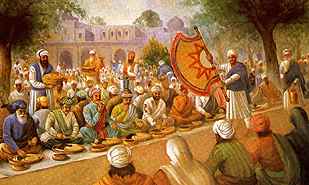 | |
| | | | | | The
Mughal Emperor Akbar at Goindwal Sahib enjoying the Guru's Langar prior to paying
homage to Guru Amardas | | | |
| | | | | | | | | | | | | 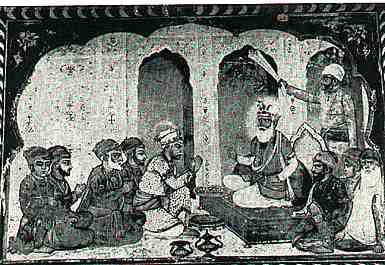 | | | | | | | | | | | |
| | | | | | | | | | | | | Emperor
Akbar in the divine presence of Guru Amardas | | | | | | | | | | | | | |
| | | | | | | | | | | The
Guru started a new centre of worship at Goindwal where he got a well dug for the
benefit of the people (See Baoli Sahib). He also perpetuated the concept of langar.
He located the site for Amritsar and directed Guru Ramdas to construct the Holy
Tank there. The Guru was very friendly with Emperor Akbar who came to pay respects
to him at Goindwal and according to the custom took meals at the langar. | | | | |
| | 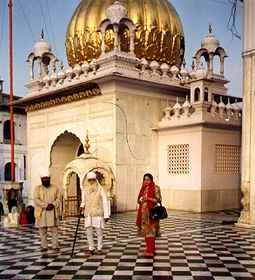 | | | | | | | | | | | | | | | | | | | | | | | | | |
| | | The
Baoli Sahib at Goindwal.The tank with 84 steps. It is believed that anyone reciting
Japuji Sahib on each of the steps will attain Moksha and break the cycle of life
and death (Churasi) | | | | | | | | |
| | | | | | | | | | | | | 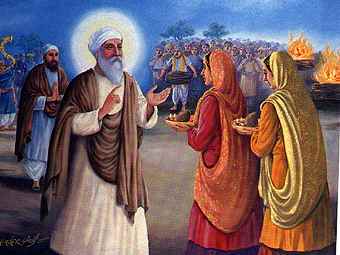 | | | | | | | | | | | | | | | | | |
| | | | | | | | | Guru
Amardas conferred equal status on men and women and disapproved of gender discrimination.
He forbade the practice of Sati - burning of wife at the pyre of husband - as
it was considered an insult to human dignity. | | | | | | | | | | | | |
| | | 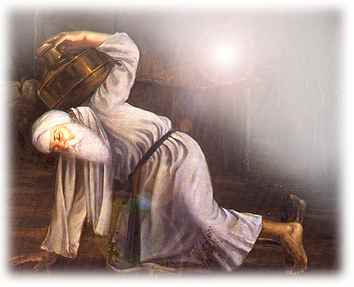 | | | | | | | | | | | | | | | | | | | |
| | | | The
Epitome of Seva (service) Guru
Amardas served his master Guru Angad for 12 years, wading through rain and storm. | | | | | | | |
| | | | | | | | | | | | | | | | | | 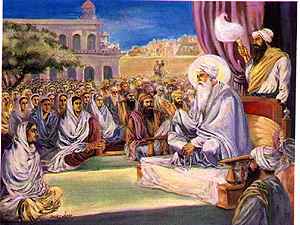 | | | | | | | | | | | | | | |
| | | | | | | | | | | | | | | | | Guru
Amardas appointed women to conduct Sikh missionary and parish work. Districts
under the charge of men were known as 'Manjian'. Those in the charge of women
were known as 'Pirhian', on which they sat to minister to the disciples. Their
selection for this important task indicated the faith of the Guru in the capacity
of women for organisational work. | | | | | | | | | | | | |
| | | | | 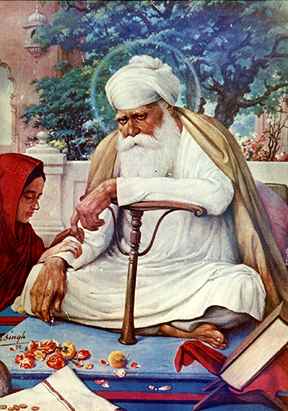 | | | | | | | | | | | | | | | | | | | | | | | |
| | | | | | The
Great Guru Amardas Ji, whose seva and devotion to Guru Angad made him eligible
to wear the holy crown of the Guru Nanak throne. Here,
"Deep in contemplation" - a mood captured by the great Sobha Singh -
the artist of the millenium. | | | | | | | | |
| | | | | | | | | | | | | | | | | | | | | 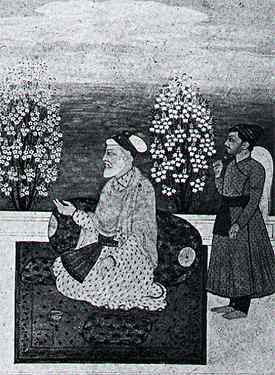 | | | | | | | | | | |
| Guru
amar das Ji. a painting at the Lahore Museum (courtesy F. Aijazzudin) Guru
Amar Das is shown as a white-bearded man, seated on a mauve carpet. Behind the
Guru stands a servant with afly-whisk. | | | | | | | | | | | | |
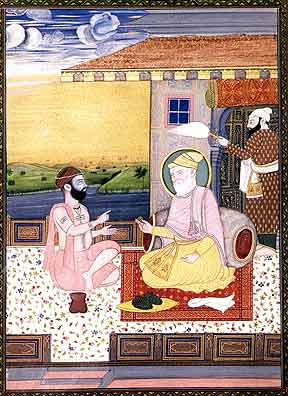 | | | | | | | | | | | | | | | | | | | | | | | | | | | |
| 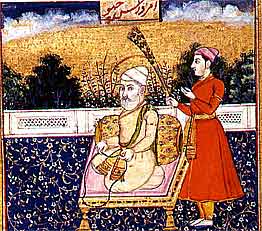 | | | | | |
| | Both
paintings of Guru Amardas by Muslim artists. (Courtesy T.S.Randhawa-"The
Sikhs") | | | | | | |
| | | | | | | | | | | | | | | | 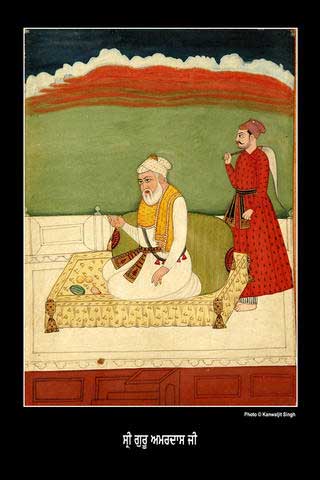 | | | | | | | | | | | | | | | |
| | | | | | | | | | | | | | | Guru
Amar Dass (courtesy Prof Balwinder Singh) | | | | | | | | | | | | | | | | |
 |  |  |  |  |  |  |  |  |  |  |  |  |  |  |  |  |  |  |  |  |  |  |  |  |  |  |  |  |  |  |  |  |  |  |  |  |  |  |  |  |  |  |  |  |  |  |  |  |  |












